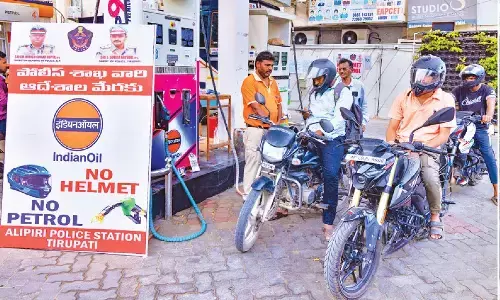Food inflation adds to people’s woes

Food Inflation Adds to People’s Woes, Escape Velocity, Real Crisis. Today, 94% of working population is engaged in the unorganized sector. Even in the organized sector, there is a major change; 40% of the people here are under contractual employment.
Today, 94% of working population is engaged in the unorganized sector. Even in the organized sector, there is a major change; 40% of the people here are under contractual employment.
Now, in India, when official number two of the ruling party has urged Dalits of the country to attain `escape velocity’ in their journey to progress, the ground reality happens to be a veritable minefield; not just for Dalits but for all sections of poor and vulnerable. It is the price situation which has subjected these sections to real crisis. And, the most ominous dimension is underlined by the skyrocketing of food commodity prices.
As rustic political wisdom in the country tends to suggest, perhaps onion is the most electorally sensitive commodity and often acts as a game changer. In the run-up to the elections, the spurt in onion prices is building up explosively.
With the opening of electoral high season where bugles and war drums sound, food inflation has come to occupy the centre stage. In comparison to the price of food items in 2004 when the first UPA government assumed office, as of now they have gone up by a whopping 157%.
The most defining feature of these price rises has been its relentless nature. One can hardly remember any other time in history where food inflation has been so unrelenting. This has been, of course, despite the equally repeated promises made by the government and the policy establishment.
The nature of food inflation has been even crueler for the most downtrodden sections. Often, public discourse on the price question does not bring out this obnoxious reality. With the persistent implementation of the neo-liberal policy doctrine, there is a distinct shift in the structural dimension of employment. Today, 94% of working population is engaged in the unorganized sector. Even in the organized sector, there is a major change; 40% of the people here are under contractual employment. Taking these two categories into account, therefore, an overwhelming majority of our people are under conditions of employment completely bereft of any social security safeguard; not to speak of dearness allowance to insulate them from this punishing food inflation.
On diagnosis of food inflation, several myths are afloat. That there has been a stupendous increase in food production in the country since the immediate aftermath of our freedom is there for all to see. It has grown from 50 million tones to the current 250 million tones. Yet, we find that the per capita availability of food grains is going down year after year. Production needs to be further enhanced; particularly India’s productivity in terms of per hectare yield lags behind many comparable economies. Pertinently, per hectare yield in India is just a third of what it is in China.
But to talk about production and about growth of population would be missing the wood for the tree. Doubtless, there is an urgent need for making public investment for enhanced agricultural production and productivity, particularly in research and technology development factoring diverse agro-climatic regions in the country. Similar emphasis needs to be attached to infrastructure for better use of natural resources like land and water. And it is also clear that since the 1990s there has been sharp deceleration in public investment for increasing production and productivity. And the entire task has been left to the whims and fancies of market. Global corporations have increasingly come to dominate seed, fertilizer and pesticide markets. Research and extension programmes initiated by publicly funded institutions are in a state of gradual phase-out.
But having pointed out these growing infirmities in production, what becomes evident is development in distribution. There have been attempts by neo-liberal brass to establish a rank anti-people concept. Leading the pack, Deputy Chairman of Planning Commission Montek Singh Ahluwalia was candid enough to point out that inflation was a necessary ‘collateral’ that people would have to bear with to sustain the trajectory of ‘growth’. But despite growth, most people have suffered on account of food inflation, while a miniscule of the population disproportionately benefited from this pattern. In fact, that small miniscule who constitute ‘shining India’ have prospered even when the GDP rates have slowed down.
It is amply clear that increase in food prices have now clearly established a pattern which is devastating the poor. Erstwhile Governor of the Reserve Bank Duvvuri Subbarao pointed out that inflation rate, especially involving food commodities, could not be accepted as ‘new normal’. And he had good reasons. In March this year, food prices rose by nearly 9%compared to 4% inflation rate for manufactured items.
The comparison of food prices with the global context is no less disturbing. In September last, rating agency Moody’s pointed out in a report that food prices in India were rising faster than the global rate.
While the World Bank food price index for emerging countries grew 3% year on year in the past 12 months, India’s food prices increased by 10%. The New York Times reported that China’s annual consumer inflation rate rose to a seven- month high of 3.1%; but it was still below the official target of 3.5% for 2013. But, in sharp contrast to Indian policy making, China is attempting to reduce credit-fuelled investment.
Looking at Indian policy discourse on food prices, clearly three villains emerge: Financialisation of the food economy wherein large swathes, like pulses, edible oil, vegetables and animal protein, remain problem areas; speculative activities and reluctance of the government to intervene in ensuring public stocks are leading to financial intermediaries and hoarders going for a kill. The second is, of course, the fuel prices because of the skewed tax policies which are leading to disproportionate increase in the price of fuel which have a cascading effect on food prices. And, finally, refusal to strengthen the public distribution system; and reluctance to improve the Food Security law is what is irking the poor.
These major concerns doubtlessly endanger the livelihood of the poor. The current spurt in vegetable prices is only an additional burden. So, Raghuram Rajan, the new poster boy of the economic establishment with his record of having forewarned the global financial crisis of 2008, claimed before his US audience that India is not in a crisis.
The slowdown arising out of shift from a consumption-led trajectory to an investment-led one is but a passing phase. Notwithstanding this brave face, he remains woefully wedded to neo-liberal insensitivity. Lack of concern for the aam aadmi is, therefore, more likely to produce electoral tears as the onion customarily does.




















